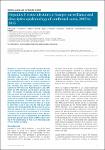Hepatitis E virus infection in Europe: surveillance and descriptive epidemiology of confirmed cases, 2005 to 2015
Aspinall, E. J.
Couturier, E.
Faber, Mirko
Said, B.
Ijaz, S.
Tavoschi, L.
Takkinen, J.
Adlhoch, Cornelia
Hepatitis E virus (HEV) is an under-recognised cause of acute hepatitis in high-income countries. The purpose of this study was to provide an overview of testing, diagnosis, surveillance activities, and data on confirmed cases in the European Union/European Economic Area (EU/EEA). A semi-structured survey was developed and sent to 31 EU/EEA countries in February 2016, 30 responded. Twenty of these countries reported that they have specific surveillance systems for HEV infection. Applied specific case definition for HEV infection varied widely across countries. The number of reported cases has increased from 514 cases per year in 2005 to 5,617 in 2015, with most infections being locally acquired. This increase could not be explained by additional countries implementing surveillance for HEV infections over time. Hospitalisations increased from less than 100 in 2005 to more than 1,100 in 2015 and 28 fatal cases were reported over the study period. EU/EEA countries are at different stages in their surveillance, testing schemes and policy response to the emergence of HEV infection in humans. The available data demonstrated a Europe-wide increase in cases. Standardised case definitions and testing policies would allow a better understanding of the epidemiology of HEV as an emerging cause of liver-related morbidity.
No license information

